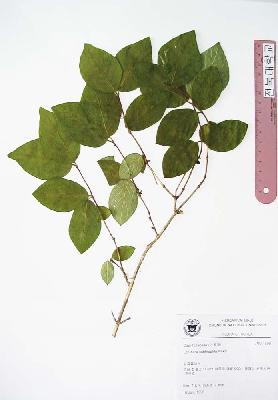낙엽성 관목으로 직립하며 높이는 1∼2 m이다. 줄기는 기부는 분지한다. 오래된 가지의 수피는 회갈색이며, 불규칙하게 세로로 갈라진다. 2∼3년생 가지는 회갈색, 암회색이며 신년지는 녹갈색이다. 가지는 약간의 강모 또는 샘이 있거나 또는 털이 거의 없어지기도 한다. 가지의 속은 백색으로 차 있다. 정아는 없어지며, 측아는 몇 개의 쌍으로 된 인편이 있으며, 안쪽의 인편은 원형에 가까운 난형이고 후성숙하여 커진다. 잎은 단엽으로 대생한다. 엽병은 길이 3∼7 mm이고, 처음에 샘이 산생하고 긴 털이 있다. 엽형은 장타원형, 타원형, 난상타원형 또는 난형으로 크기는 4∼7 × 2.2∼5 cm이다. 엽선은 급첨두 또는 예두이고, 엽연은 전연이며 섬모상의 거친 털이 있고, 엽저는 원저 또는 설저이다. 잎의 양면은 거친 복모와 드문드문 강모가 있다. 잎의 표면은 녹색을 띠며, 털이 성기게 있으며, 이면은 다소 백색을 띠며, 맥에는 짧고 뻣뻣한 털이 있다. 화서는 액생한다. 새 가지의 엽액 기부에서 나오며, 축소되어 1개의 꽃으로 핀다. 때때로 발달이 미약한 꽃이 추가로 달리기도 한다. 화경은 개화기에 길이 0.5∼1.2 mm이며, 과기에는 후 성숙하여 25 mm에 이르고, 드문드문 선모가 퍼져 달린다. 포는 대개 1개이며, 때때로 축소된 포가 대생으로 달리기도 하며, 넓은 피침형 또는 난상피침형, 길이는 7∼14 mm로 뻣뻣한 털과 선모가 있다. 소포는 없다. 꽃의 개화기는 5월이다. 양성화이고, 완전화이며, 누두형이고, 방사상칭으로, 화색은 황색을 띤다. 꽃받침은 깍정이 모양으로 기부가 붙어 있으며, 털이 없고, 길이는 0.3∼0.5 mm이며, 가장자리는 편평하거나 치아상이다. 화관의 길이는 15∼20 mm이고, 통부의 기부는 둥근 형태로 볼록해진다. 열편은 크기와 모양이 비슷하고, 통부 길이의 1/2 정도이며, 바깥쪽으로 긴 털이 있고 드물게 샘이 있다. 수술은 털이 없으며, 수술대의 길이는 화관의 길이와 비슷하다. 암술은 털이 없으며, 암술대의 길이는 화관의 길이와 비슷하다. 자방에는 샘이 드물게 분포한다. 열매는 6월에 성숙한다. 장과이며, 방추형 또는 타원형이다. 열매의 길이는 8∼14 mm이며, 털이 없다. 종자 길이는 3.5∼4 mm이다.
털괴불나무(L. subhispida)는 함경남도 강진군의 강구와 상리에서 채집된 표본을 근거로 Nakai (1921)에 의해 특산 신종으로 발표된 종이나 다양한 식물연구 그룹에서 털괴불나무의 남한 내 분포를 확인하였다는 정보를 얻지 못하고 있다. 이에 따라 털괴불나무는 북한지역의 평안도, 함경도 및 양강도 지역에 분포하는 북방계 식물로, 현재까지의 결과에 따르면 남한에서는 분포하지 않는 것으로 판단한다.
Description
Shrubs deciduous, erect, 1∼2 m tall. Stems ramified from the ground; old bark splitted irregularly and longitudinally, grayish brown; 2∼3 year-old branches grayish brown to dark gray, new branches greenish brown; branches glandular and slightly setose or subglabrous, solid with white pith; terminal bud vanished, lateral buds with several pairs of scales, inner ones accrescent and orbicular ovate. Leaves opposite, simple; petiole 3∼7 mm long, at first hirsute and sparsely glandulous; leaf blade oblong, elliptical, ovato-elliptical to ovate, 4∼7 × 2.2∼5 cm, apex mucronate or acute, margin entire, bristly ciliate, base rounded to cuneate; both surfaces adpressed hispid and sparsely setose, adaxial surface greenish, loosely ciliary, abaxial surface somewhat whitish, scabrous in vein. Inflorescences axillary at base of new shoots, reduced to a single flower or sometimes with a second flower partially developed; peduncle 0.5∼1.2 mm at anthesis, accrescent to 25 mm in fruit, sparsely spreading glandular hairy; bract usually 1, sometimes with an opposite reduced bract, broad or ovate lanceolate, 7∼14 mm, stiffly hairy and glandular hairy; bracteole absent. Flowers May, bisexual, complete, funnel form, corolla tube and lobes actinomorphic, yellowish; calyx united at base, cupular, glabrous, 0.3∼0.5 mm long, margin truncate to toothed; corolla 15∼20 mm long, tube gibbous toward base; lobes regular, subequal in size and shape, to half as long as tube, outside hairy and sparsely glandular; stamens glabrous, subequaling corolla; style glabrous, subequaling corolla; ovary with sparse glands. Fruits Jun., berry, fusiform or ellipsoid, 8∼14 mm long, glabrous. Seeds 3.5∼4 mm long.
Distribution
China, Russia, Korea (Pyengbuk, Hamnam, Hambuk)
Reference
Silvics of Korea. Vol. 4 (2020), English Names for Korean Native Plants (revised edition, 2022)
English common name
Bristle honeysuckle

 식물자원
식물자원

 국가생물종지식정보시스템 >
국가생물종지식정보시스템 > 
















